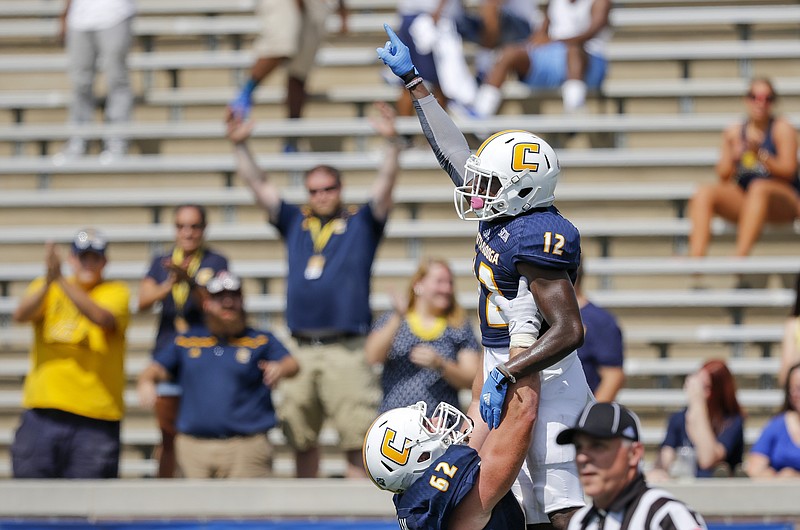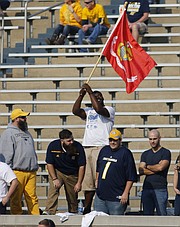In one of his first interviews with Chattanooga media as Richmond's new head football coach, Russ Huesman admitted he was "disappointed" in the dwindling crowds for the University of Tennessee at Chattanooga, his former employer. After a major spike in attendance his first season and continued small growth, Finley Stadium numbers dipped considerably in his final season despite a run of success not seen in a long time.
The Mocs historically have been successful in the Southern Conference, and that was enhanced by the football program's recent four-year run that included 36 wins, three conference championships and three national playoff appearances. Yet the average home attendance fell to 8,886 in 2016, the program's lowest number since 2008 - the season before Huesman arrived as head coach.
In first-round playoff victories over Fordham (2015) and Weber State (2016), the attendance was 10,126 - combined. In a facility with a seating capacity of 20,668, that's about 25 percent full - the equivalent of about 26,000 showing up at a game at Tennessee's Neyland Stadium or Alabama's Bryant-Denny.
Sometimes perception is reality, and in a city where nine Southeastern Conference schools are within five hours, the perception is that there are more enticing options available than going to a UTC game on a Saturday afternoon, regardless of how successful the Mocs are.
Some of that drop could be attributed to popular former opponents Appalachian State and Georgia Southern moving out of the SoCon to the Football Bowl Subdivision and Sun Belt Conference in 2014. Four of the top 10 crowds in Finley Stadium history have come against either the Mountaineers or Eagles.
So is there an answer? Some fans complained about the start times - 11 of the 13 home games the past two seasons have started at 4 p.m. or earlier - but the thought is that later start times would yield similar attendance figures.
The administration has preferred earlier start times to try to maximize the number of people in the stands, with the thought that fans of SEC schools could go watch a UTC game, then get home in time to watch their favorite program play.
In the last 18 months, conversation about a potential move to another conference has ramped up, with the obvious need for something to change to get people in the stands. Sources have told the Times Free Press that the university could explore a move in the next three to five years, with two options seeming the most likely: a move up to the Sun Belt or a lateral move to the Ohio Valley.
Why the Sun Belt?
Well, money.
It would cost UTC $1 million to leave the SoCon - as long as the school gave a year's notice - and $2 million to join the new league, but there are ways that money could be made up.
For one, rejoining a league with Appalachian State and Georgia Southern could guarantee at least one big-money ticket gate each year (and if the schedule broke the right way, possibly two). In addition, Georgia State is in close proximity, and Coastal Carolina, Troy and South Alabama aren't too far away.
The Mocs usually play one big-money game against a high-level FBS team a season. This September they're scheduled to make $500,000 for a Sept. 9 game at LSU. That number could be bumped up to around $1.1 million as a FBS program, as the payout increases for Power Five teams looking for what they would consider "guarantee" games.
The move could benefit the city as well. Sources have told the Times Free Press that the Sun Belt would consider making Chattanooga home for the league offices, with the possibility of the conference basketball tournament being held at McKenzie Arena. UTC won two of the last three SoCon men's tourneys held at McKenzie.
Plus with the benefits of nationally televised games and potential bowl games, the Mocs could find themselves with an opportunity to profit off the exposure benefited to them by a move up.
There would be more travel involved, although not nearly as much on average as one may think. The longest trip for the Mocs would be Texas State in San Marcos, which is 977 miles from Chattanooga. The average Sun Belt trip is 436 miles, which is 160 miles more (on average) than SoCon travel, with the longest trips in the current league being to UNC Greensboro, The Citadel and Virginia Military Institute.
More money coming to the athletic department could also lead to more money to pay coaches. Since the end of the 2015 basketball season, UTC athletic director David Blackburn has had to replace two men's basketball head coaches and a head football coach, all of whom left for higher-paying jobs.
The OVC?
A lot of people have suggested over the years that UTC kick the tires on the OVC. Moving from one FCS conference to another may not sound like a good move, but the logistics have to come into consideration.
That pesky attendance problem probably would be helped pretty quickly. Not only is UTC's primary football rival, Jacksonville State, in the OVC, but it includes potential in-state rivals Austin Peay, Tennessee State, Tennessee Tech and UT-Martin, all of which have alumni in the Chattanooga area. Throw in Belmont in basketball and it may be the most logical fit.
The average distance for an OVC trip for UTC would be 248 miles - less than that of the average SoCon trip - and the money the university could make up with more bodies in the stands would be an added benefit.
The solution?
That would end up in the hands of the administration. Huesman and Blackburn have done their part to make sure there was a good product on the field on Saturdays during football season, but for the most part people have spoken with their wallets that UTC doesn't have a product they want to see.

Huesman's former job now falls on Tom Arth and his staff, and they've inherited an inexperienced roster that will get better as the 2017 season goes on. The first home game of the 2017 season will be on Sept. 16 against UT-Martin, but that will come after a neutral-site game against Jacksonville State on national television and a game at LSU in what will be new Tigers coach Ed Orgeron's home opener.
The administration could choose to stand pat. A budding rivalry with Mercer has started to develop in all sports, and with East Tennessee State back in the SoCon and now fielding a football team, there's still the chance that in a few years that rivalry will have been built back up after being absent for over a decade. Plus Samford is close enough that there are enough Bulldog alumni in the area.
But for every ETSU and Mercer, there's a Wofford, Citadel or Furman that, while big games for the teams and the core fan base, just don't have the appeal to get the average fan in the stands.
The best solution could be that it's time for UTC to leave, and while it would cost the Mocs some to go, one major question remains.
How much is it costing them to stay?
Contact Gene Henley at ghenley@timesfreepress.com. Follow him on Twitter @genehenleytfp.

